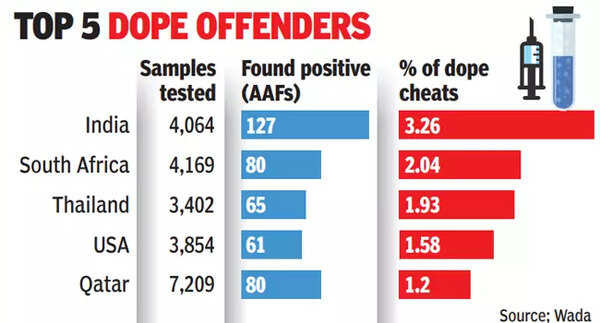NEW DELHI: In an embarrassing revelation for the country’s anti-doping machinery, India ranked first among countries with the highest percentage of
dope offenders
in 2022 testing figures released by the
World Anti-Doping Agency
(
WADA
).
The total collected samples of Indians stood at 4,064 (urine, blood and athlete biological passports combined). 127 Indian athletes were caught for using banned substances, which amounts to 3.26% of the sample size.
The samples were tested at the National Anti-Doping Laboratory (NDTL) situated at the JLN stadium here.
The figure was based on failed drug tests among nations which had more than 2000 samples tested by their respective testing laboratories.

India also ranked first among nations with the highest percentage of failed EPO-Receptor Agonists (ERA) tests conducted per laboratory (blood), which stood at 1.8 percent or 11 cases of adverse analytical findings (AAFs).
This highlights how deep the menace runs in the Indian sporting ecosystem, emphasising on the need to have a robust scientific and research system in India. The figures also highlighted that Indian coaches, doctors and physiotherapists – attached with teams of different disciplines – lack basic knowledge about banned supplements and medicines.
South Africa is second in the list with 80 dope failures — 2.04% from 4,169 samples tested. Bangkok’s testing laboratory stood third with 1.93% of its testing pool of 3,402 samples returning 65 cases of adverse analytical findings (AAFs).
USA is fourth in this list and Qatar fifth.

India’s number of
doping
violations have been higher than some of the major sporting nations like Russia (85), USA (84), Italy (73) and France (72).
China tested the maximum number of samples – 17,357 – during the counting period and reported an adverse findings percentage of 0.25% .
“WADA’s annual testing figures report is the most comprehensive overview of all doping control samples analysed and reported by Wada-accredited and Wada-approved laboratories around the world. Wada is pleased to note that the number of anti-doping tests in the testing figures continue to increase across the board and are the closest to the pre-pandemic levels (2019). The testing figures report is an important tool for collaboration between anti-doping organisations,” WADA director general Olivier Niggli said.









 English (US) ·
English (US) ·